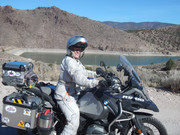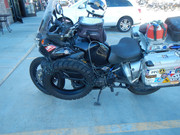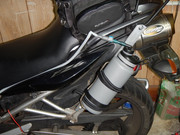This is a pretty old thread. Over your body temp in ambient temp, mesh just dehydrates you even faster. Some would draw the line at about 95F.
Ideally, stay away from cotton as a base layer. It retains too much moisture and holds it against your skin. A fabric like LDComfot uses will hold the moisture, but keep your skin dry and avoid rash, but still work very, very well as a cooling method.
It makes me cringe when someone types about drinking when stopped. It is much, much more efficient to drink while riding. And I'm not just talking about stopped time, I'm talking about hydrating your body. Many sips is far better than big drinks at stops. You can't absorb those big drinks as well as smaller sips. It's too late when you get dehydrated. You're not going to recover by sucking down a couple of gatoraids at a stop. Preventing dehydration in high heat means taking a sip when ever you think about it. A gallon of ice water with a drinking hose on extreme days won't get you thru the entire day if you're staying hydrated.
It can be very inexpensive to create your hydration system that will allow you to drink while riding and not wear your water. Pick an insulated jug you like and think about where you will mount it. The passenger footpeg is a common spot. Or the rear rack for those that have that area free. Some food grade tubing from the freezer section of the Home Depot or Lowes, a bite valve from the sporting goods store, Amazon, etc and a card or key retractor and you're in business.
My wife's GSA uses a 1 gal Bubba Keg and I attached an aluminum plate to her footpeg after removing the factory rubber and drilling one more hole. Using the existing hole and the new hole I secured a dog dish and the aluminum plate to her foot peg. Drilling some small holes allowed me to insert bungee cord hooks into the holes, closing the hook to capture them on the back side, then two more holes on the front for the criss cross bungies to attach to the dish after going over the jug. A length of tubing and a bite valve with an ID card retractor to keep the bite valve end at the bars when she's not sipping from it and you're done. Total cost about $40.

On my bike I had room on my flat bed fuel cell, so used a $3 cake pan from WalMart, a $5 1 Gal Igloo jug from ebay, (free shipping!), a mix of hard and soft tubing, two quick release fittings, (Camelbak), a bite valve and a key retractor. The Q/R fittings were expensive, $10 each, so my total cost was still about $40. The Q/R fittings make it easy to remove the jug for filling, or take the tank bag inside at hotel stops. The webbing and plastic buckles to retain the jug to the cake pan cost me $7 for webbing and buckles and $3 for the local equestrian tack repair shop to sew up. I already had the key retractor and bite valve and the tubing was from the same roll I bought to do my wife's set up.

I'm making a mini hydration system for my day ride bike now. I spent more than I usually do on a system since the FZ6 has very little available space for a bigger jug. A
Tal 40 oz insulated jug for $15 - a $5 coupon, so $10, (the 64 oz costs the same at WalMart), a
Blackburn Outpost cargo water bottle rack was a splurge at $25, a $5 piece of aluminum bar from the local metal supply house, a
bite valve, $6, a
Q/R fitting, $6, some tubing, plus a key retractor & hardware I already had. Total cost $52. I can upgrade to the 64 oz jug or some other insulated 1/2 gal jug by just swapping jugs. The Blackburn rack will hold a variety of sizes and has long straps to secure the jug. I could have taken my jug to the local thrift stores and found a metal cup the right size and bolted that to my aluminum bar instead, saving me most of the $25 I spent on the Blackburn rack. Shopping around helps too! I saved about $6 on the rack by shopping around and got free shipping.





